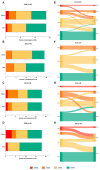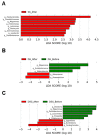Effects of Synbiotic Supplementation on Metabolic Syndrome Traits and Gut Microbial Profile among Overweight and Obese Hong Kong Chinese Individuals: A Randomized Trial
- PMID: 37836532
- PMCID: PMC10574554
- DOI: 10.3390/nu15194248
Effects of Synbiotic Supplementation on Metabolic Syndrome Traits and Gut Microbial Profile among Overweight and Obese Hong Kong Chinese Individuals: A Randomized Trial
Abstract
In view of the limited evidence showing anti-obesity effects of synbiotics via modulation of the gut microbiota in humans, a randomized clinical trial was performed. Assessment of the metabolic syndrome traits and profiling of the fecal gut microbiota using 16S rRNA gene sequencing in overweight and obese Hong Kong Chinese individuals before and after dietary intervention with an 8-week increased consumption of fruits and vegetables and/or synbiotic supplementation was conducted. The selected synbiotic contained two probiotics (Lactobacillus acidophilus NCFM and Bifidobacterium lactis HN019) and a prebiotic (polydextrose). Fifty-five overweight or obese individuals were randomized and divided into a synbiotic group (SG; n = 19), a dietary intervention group (DG; n = 18), and a group receiving combined interventions (DSG; n = 18). DSG showed the greatest weight loss effects and number of significant differences in clinical parameters compared to its baseline values-notably, decreases in fasting glucose, insulin, HOMA-IR, and triglycerides and an increase in HDL-cholesterol. DSG lowered Megamonas abundance, which was positively associated with BMI, body fat mass, and trunk fat mass. The results suggested that increasing dietary fiber consumption from fruits and vegetables combined with synbiotic supplementation is more effective than either approach alone in tackling obesity.
Keywords: diet; fruits and vegetables; gut health; gut microbiota; insulin resistance; metabolic syndrome; obesity; probiotics; synbiotics; weight loss.
Conflict of interest statement
The authors declare no conflict of interest.
Figures













References
-
- Centre for Health Protection Obesity. [(accessed on 8 October 2022)]; Available online: https://www.chp.gov.hk/en/healthtopics/content/25/8802.html.
Publication types
MeSH terms
Substances
Grants and funding
LinkOut - more resources
Full Text Sources
Medical

